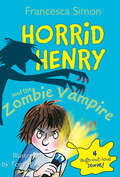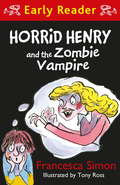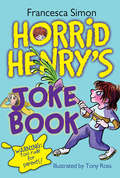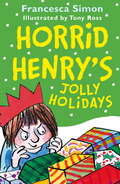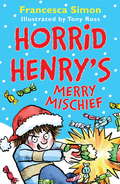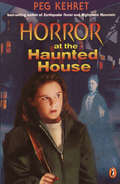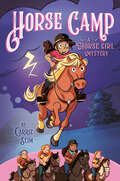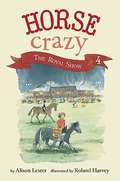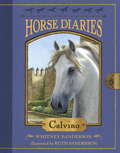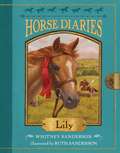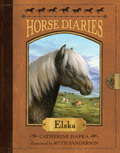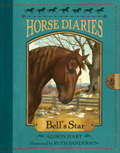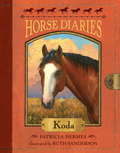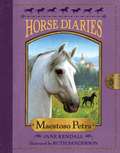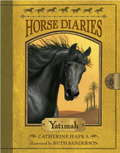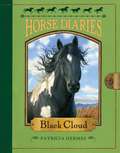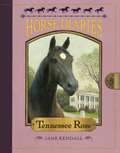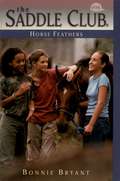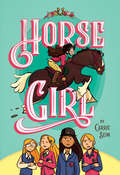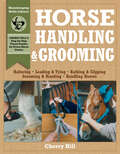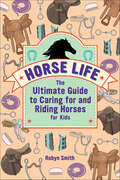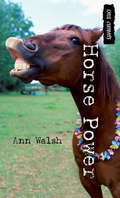- Table View
- List View
Horrid Henry and the Zombie Vampire
by Fracesca SimonHenry knows that a class sleepover at a museum can only be one thing--boring! So he's invited a few party crashers to liven things up...zombie vampires! Plus three other stories that will leave you screaming for more.
Horrid Henry and the Zombie Vampire (Horrid Henry Early Reader #40)
by Francesca SimonEarly Readers are stepping stones from picture books to reading books. A blue Early Reader is perfect for sharing and reading together. A red Early Reader is the next step on your reading journey.Henry's class are on a spooky school trip to the local museum, but could there be a terrifying zombie vampire on the loose? Henry soon has his classmates believing Miss Battle-Axe and Miss Lovely might be scarier than they seem . . .A hilarious and horrid Early Reader from bestselling author Francesca Simon, and illustrator Tony Ross.
Horrid Henry's Joke Book (Horrid Henry #0)
by Tony Ross Francesca SimonWarning: Too rude for parents and for slimy toad little brothers! These are Horrid Henry's very own jokes: the jokes that grossed out Mom and Dad... that made Aunt Ruby run home... that sent Miss Battle-Axe screaming from class. Be horrid! Read Henry's jokes. Then tell them to the world!
Horrid Henry's Jolly Holidays
by Tony Ross Francesca SimonCelebrate a truly horrid Christmas with Horrid Henry and this festive storybook bind-up.Packed with six favourite Horrid Henry stories, plus bonus content to make sure Christmas is stuffed full of cheeky festive fun.This is the perfect stocking filler for Horrid Henry fans everywhere!Stories included are:Horrid Henry's Birthday Party Horrid Henry's Sleepover Horrid Henry Goes ShoppingHorrid Henry and the Bogey BabysitterHorrid Henry's Horrid WeekendHorrid Henry Robs the Bank
Horrid Henry's Merry Mischief
by Tony Ross Francesca SimonCelebrate a truly horrid Christmas with Horrid Henry and this festive storybook bind-up.Packed with six favourite Horrid Henry stories, plus bonus content to make sure Christmas is stuffed full of cheeky festive fun.This is the perfect stocking filler for Horrid Henry fans everywhere!
Horror at the Haunted House
by Peg KehretIt was a job any kid would kill for: to play a role in the Historical Society's Haunted House Halloween fundraising event. Ellen Streater was thrilled to play Joan of Arc, burning at the stake. It was for a good cause -- to benefit the eerie old Clayton House, soon to reopen as a museum. They said the house was haunted. Ellen didn't believe it -- until she felt a strange, icy feeling when she touched the beautiful Fairylustre bowl. Then she saw the ghost in the mirror -- a beautiful phantom who beckoned her into a nightmare beyond her wildest imagination.
Horse Camp: A Horse Girl Mystery (Horse Girl)
by Carrie SeimYEE-HAW! Willa is back in this standalone sequel to Horse Girl. This time, she tackles summer camp, new and old frenemies, and worst yet: a horse that's mysteriously gone missing.Seventh-grader Willa is head-over-hooves when she finds a secret note inviting her to Juniper Ranch—a sleepaway camp that&’s all about horses. The camp promises trail rides, horseback swims, and &“ghorst&” stories, plus tons of new horse-girl and (gasp!) horse-boy friends. Even better? Willa&’s pals from Oakwood Riding Academy—including her sworn frenemy, Amara—are all coming along for the fun.But when Willa makes a dangerous mistake and a beloved steed goes missing, everyone at Juniper Ranch is suddenly a suspect. Wills isn&’t sure who to trust (including herself) as she tries to figure out who&’s behind the mysterious horsenapping. And where they might be lurking. And just how she&’ll save her &“forever herd&” before a frightening storm rolls into camp. Gulp!
Horse Crazy 4: The Royal Show
by Alison Lester Roland HarveyWhen Bonnie and Sam receive the invitation of their dreams to assist their riding teacher at the Royal Show they can't believe it! But on their way they encounter a starving pony that needs their help, and they must figure out a way to rescue the pony and help their teacher. The suspense will enthrall young readers as the two friends overcome a number of obstacles on their journey.
Horse Diaries #14: Calvino
by Ruth Sanderson Whitney SandersonFor all lovers of horses and history! This latest book in the Horse Diaries series features an Andalusian horse in romantic sixteenth-century Spain. Southern Spain, 1570s Calvino is a dapple-gray Andalusian stallion. He grew up driving cattle in the mountains, but soon he catches the eye of King Philip II’s horse master. Now Calvino and his young rider, Rico, must learn the complicated moves of doma clásica riding. Calvino doesn’t understand the use of this prancing—until he and Rico are chosen to represent the king in a deadly bullfight that will put all his skills to the test. Here is Calvino’s story . . . in his own words. Praise for Elska (Horse Diaries #1): “A must for horse lovers, the cozy and exciting adventure will draw a wide audience.” —Booklist
Horse Diaries #15: Lily
by Ruth Sanderson Whitney SandersonFor all lovers of horses and history! In the latest book in the Horse Diaries series, meet Lily, a strawberry roan Welsh pony with a competitive heart!SOUTH WALES, 1939: Lily, a strawberry roan Welsh pony, loves Pony Club! She and her rider, Gwen, compete in and win lots of events, including Lily's favorite--jumping! Then Bridget joins the Pony Club. The English girl was sent from London to escape the bombings brought on by war. Gwen tries to be friends, but Bridget is sour and mean. Even worse, Bridget and her horse, Bron, make the perfect jump look easy. Now Gwen and Lily have some real competition. . . .
Horse Diaries #16: Penny (Horse Diaries #16)
by Whitney SandersonFor all lovers of horses and history! In the latest book in the Horse Diaries series, meet Penny, a blue-eyed palomino paint mare who grows up in the Wild West of California during the Gold Rush!CALIFORNIA, 1850. Penny is a blue-eyed palomino paint mare with a taste for adventure! She and a boy named Jesse search for gold in the hills of Northern California. After striking it rich and then losing everything, Jesse and Penny join the Pony Express. The job is a tough one, but Penny loves a challenge! Here is Penny's story . . . in her own words.Love horses and history? Don't miss the stories of Elska, Bell's Star, Calvino, Lily, and more in the Horse Diaries series!
Horse Diaries #1: Elska (Horse Diaries #1)
by Catherine Hapka Ruth SandersonIceland, circa AD 1000Elska is a silver dapple Icelandic filly. She spends summers frisking about the countryside and winters in the farmyard, where the girl human Amma takes special care of her. But when a powerful neighbor notices Elska, her contented life suddenly changes. Here is Elska's story . . . in her own words.From the Hardcover edition.
Horse Diaries #2: Bell's Star
by Alison Hart Ruth SandersonVermont, 1850sBell's Star is a brown Morgan colt with a white star and two white stockings. He was bred for hard work, yet he longs to run free with his human friend, Katie, on his back. But when Star helps rescue a runaway slave girl, his ideas about freedom may change forever. Here is Star's story . . . in his own words. With exciting and knowledgeable text and lovely black-and-white art throughout--both by real horse owners--Horse Diaries are the perfect fit for all lovers of horses and history!From the Hardcover edition.
Horse Diaries #3: Koda
by Patricia Hermes Ruth SandersonFor anyone who has ever dreamed of hearing a horse's story . . .Independence, Missouri, 1846Koda is a bay quarter horse with a white blaze. He loves to explore the countryside and run free with his human friend Jasmine nearby. But after Koda sets out with Jasmine's family on a long and dusty wagon train journey on the Oregon Trail, he finds out what is truly important to him. Here is Koda's story . . . in his own words.With moving and knowledgeable text and lovely black-and-white art throughout--both by real horse people--this is the perfect fit for all lovers of horses and history!From the Trade Paperback edition.
Horse Diaries #4: Maestoso Petra (Horse Diaries #4)
by Ruth Sanderson Jane KendallVienna, Austria, 1938Maestoso Petra is a world-famous Lipizzaner stallion. He has spent years in the Spanish Riding School, training to perform the complex airs above the ground that only Lipizzaner can accomplish. But when World War II breaks out in Europe, he learns to think less about performing and more about survival. Here is Maestoso Petra's story . . . in his own words.From the Trade Paperback edition.
Horse Diaries #6: Yatimah
by Catherine Hapka Ruth SandersonFor all lovers of horses and history, it's the next book in the popular Horse Diaries series. Born in the Arabian Desert in the ninth century, Yatimah is a black Arabian filly whose name means "orphan." She enjoys her life at the oasis, with sheep to tease, other foals to race, and the daughter of her Bedouin owner to take care of her. But when the colt who is her foster brother is stolen in a raid, Yatimah realizes her true birthright. Like Black Beauty, this moving novel is told in first person from the horse's own point of view and includes an appendix full of photos and facts about Arabian horses and Bedouin culture.From the Trade Paperback edition.
Horse Diaries #7: Risky Chance (Horse Diaries #7)
by Alison Hart Ruth SandersonFor all lovers of horses and history, it's the next book in the popular Horse Diaries series. Born in California at the start of the Great Depression, Risky Chance is a gray thoroughbred who was born to race. Life at the track and being spoiled by his jockey's young daughter, Marie, is all Chance could ask for. He loves nothing more than running fast and winning. But after an accident, Chance discovers a side of horse racing that has little to do with glory.Like Black Beauty, this moving novel is told in first person from the horse's own point of view and includes an appendix full of photos and facts about thoroughbreds, horse racing, and the Great Depression.From the Trade Paperback edition.
Horse Diaries #8: Black Cloud (Horse Diaries #8)
by Patricia Hermes Astrid SheckelsBorn in Northern Nevada in 1950, Black Cloud is a black-and-white mustang colt. He loves roaming free with the rest of his herd, playing with the other foals, and learning the ways of wild horses. But when humans intrude on this wandering life, Black Cloud's worled is changed forever. Like Black Beauty, this moving novel is told in first person from the horse's own point of view and includes an appendix full of photos and facts about mustangs and the history of the laws protecting them.From the Trade Paperback edition.
Horse Diaries #9: Tennessee Rose (Horse Diaries #9)
by Jane Kendall Astrid SheckelsAlabama, 1856. Tennessee Rose is a dark bay Tennessee Walking Horse with a rose-shaped marking on her forehead. She loves dashing around the plantation in the running walk that her breed is famous for, then coming back to her comfortable stall and her friend Levi, the slave boy who is her groom. But as the Civil War approaches, Rosie begins to question plantation life. Is slavery fair? Could Levi be free? Like Black Beauty, this moving novel is told in first person from the horse's point of view and includes an appendix full of photos and facts about Tennessee Walking Horses and the Civil War.
Horse Feathers (Saddle Club #98)
by Bonnie BryantStevie Lake's a mom-to eight fuzzy goslings!Stevie Lake entered a contest to win a down comforter. Instead she got a new "family"-a nestful of goose eggs. But when the eggs hatch, it's love at first sight for Stevie and the goslings. Now Stevie's learning that being a mom is hard work: the goslings want to go everywhere Stevie goes, even to Pine Hollow. Stevie has to keep her "kids" safe while trying to learn a new skill-vaulting. The Saddle Club is determined to master vaulting and show Veronica diAngelo that success takes more than fancy coaches. Can they pull this off? Or is The Saddle Club plus eight goslings and one vaulting horse a recipe for disaster?
Horse Girl
by Carrie SeimMean Girls meets Black Beauty in Horse Girl by celebrated author Carrie Seim--a funny and tender middle-grade novel about finding your forever herd."This book is funny and exciting. Beautifully portrays both the pleasures and risks of riding horses and also of being a teen. Very original, and a great pleasure to read."--Jane Smiley, Pulitzer Prize-winning author Wills is a seventh grader who's head-over-hoof for horses, and beyond excited when she gets the chance to start training at the prestigious Oakwood Riding Academy. But Amara--the Queen of the #HorseGirls--and her posse aren't going to let the certifiably dork-tagious Wills trot her way into their club so easily. Between learning the reins of horse riding, dealing with her Air Force pilot mom being stationed thousands of miles from home, and keeping it together in front of (gasp!) Horse Boys, Wills learns that becoming a part of the #HorseGirl world isn't easy. But with her rescue horse, Clyde, at her side, it sure will be fun.Complete with comedic, original hoof notes to acquaint the less equestrian among us, Horse Girl delivers everything a young readers wants: mean girls, boy problems, and embarrassingly goofy dad jokes. And it does so on the back of a pony.
Horse Handling & Grooming: Haltering * Leading & Tying * Bathing & Clipping * Grooming & Braiding * Handling Hooves (Horsekeeping Skills Library)
by Cherry Hill Richard KlimeshWith easy-to-follow instructions and clear photographs, this guide shows you everything you need to know to safely and effectively handle and groom your horse. Veteran trainer Cherry Hill shares expert techniques for haltering, tying, clipping, bathing, braiding, leading, blanketing, and more. Learn how proper horsekeeping not only helps your animal look and feel its best, but can enhance the special bond between horse and rider. Horse Handling & Grooming will help riders of all abilities improve, and even expand, their horsekeeping skills.
Horse Life: The Ultimate Guide to Caring for and Riding Horses for Kids
by Robyn SmithThe complete beginner's guide to horses and riding for kids 8 to 12 This ultimate guide to horses for kids teaches you all about the basics of equine care—from anatomy to housing to bathing and feeding. Whether you're just starting out or already have a horse of your own, you'll learn how to ride, how to stay safe around horses, and how to develop a healthy and friendly relationship with them.Horse basics—Brush up on your techniques and learn about all the necessary gear, with illustrations to explain horse body language, horse lingo, the different ways horses move, and much more.Safety first—This standout book on horses for kids demonstrates the best practices to keep you and your horse safe during handling, training, riding, and grooming.The perfect horse for you—Learn all about the qualities of different types of horses so you can figure out your dream breed.If you're a horse lover, Horse Life is your perfect companion for getting ready to saddle up. Additionally, this book makes a wonderful Christmas book or stocking stuffer for kids who are passionate about horses.
Horse Play (Horse Crazy #5)
by Virginia Vail Daniel BodeThirteen-year-old Emily and her fellow campers at Webster's Country Horse Camp fear that the owner plans to sell his land to a real estate developer, so they stretch the truth a bit in trying to convince the developer of imaginary hazards on the property. Picture descriptions present.
Horse Power (Orca Currents)
by Ann WalshOnce again Callie is forced to take part in her mom's latest crusade. They head into ranch country to camp -- bloodthirsty mosquitoes, stinky outhouses and all -- at a protest to save a rural school. Callie's grandmother shows up with her biker buddies and the singing grannies. Callie hates camping and wants nothing to do with the protest. To make matters worse, Callie's only possible ally, her cousin Del, is mad at her. The last time Callie visited, she was thrown from Del's horse, Radish. Callie claimed the horse was vicious and now Del's parents are forcing her to sell Radish. Callie wants to help her cousin, but she's terrified of the horse. Del is just as tenacious as the rest of Callie's family, and Callie is forced to admit that she's not going to be allowed to go home until both the horse and the school are saved.
